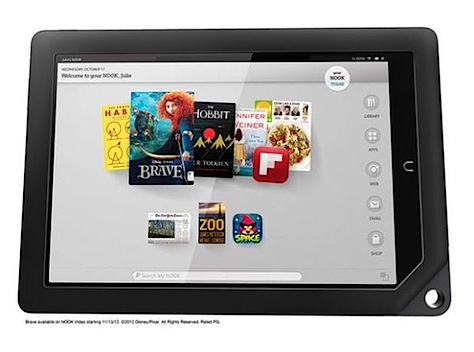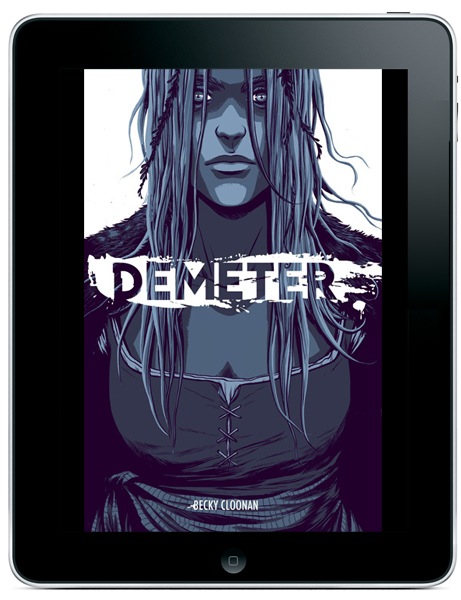by Bruce Lidl
Currently, the barrier to entry for the world of digital comics is not particularly high, as anybody with either a smartphone or a connected computer can buy and view comics from a variety of online retailers. However, to really get the best experience of digital comics, many would recommend consuming them primarily on a tablet device of some kind, with Apple’s iPad as the iconic exemplar. A big, bright screen with a very high resolution, combined with a powerful processor and a very mature operating system, reading comics on the iPad has been touted as a prime use case of the device almost since its debut in spring 2010. And comiXology’s Comics app has played a central and massively successful role in feeding those tens of millions of iPads with graphic content, presented cleanly and slickly.
Of course, not everyone is in a position to afford an iPad (full size models currently start at $499 going up to $799, while the smaller iPad Mini is priced at $329-529) or resist tying themselves to the Apple ecosystem of devices and content. Alternatives to iPads in the tablet world have been slow to take off, but the enormous penetration of Android phones has now propelled other tablets, with Google’s Nexus 7, the Samsung Tab line, the Nook line from Barnes & Noble and maybe most popularly, the Amazon Kindle Fire tablets. Significantly less expensive, far less locked down software-wise than the iPad, and with a larger diversity in size and format, the “second” wave of Android tablets has finally created a widespread user base for digital comics on tablets that are not from Apple.
Yet, while clearly (and deliberately) less expensive, the price tags for the popular Android tablets have generally stayed above $200 dollars, especially on those from name brands or with good screens. Until now, that is, as market pressures and internal disruptions among the tablet makers has brought a significant and inescapable downward price trend among the Android entries. Most notably, the Barnes&Noble line of Nook tablets, the 7 inch “HD” and the 9 inch “HD+,” both have seen their prices drop precipitously in just the last couple of weeks. Amid speculation that B&N are abandoning their foray into hardware*, the HD has gone from $199 to $129 and the HD+ has dropped all the way from $269 to $149. These devices are, in the words of one tech expert, “ridiculously” cheap, particularly for tablets with quite excellent screens, and with high resolution and good color.
(*Speculation that B&N confirmed yesterday, they are in fact ending the Nook line of tablets)
For someone looking to read comics on a tablet, but to do it on the cheap side, the Nook HD models are ideal, as I discovered for myself after taking advantage of the new pricing just before Father’s Day. I went for the HD+, and have found it to be a great digital comic book reader, and a pretty decent tablet overall. Slightly smaller, but definitely lighter than a full size iPad (515g vs. 650g), the Nook HD+ displays comics from comiXology, Dark Horse, iVerse, etc. outstandingly well, with great crispness and bold colors.
The screen size is noticeably larger than the 7 inch displays of the Nexus 7 or the original Kindle Fire, making a full comic page quite readable without having to zoom and pan as is often necessary on smaller screens.. The Dual Core Texas-Instruments OMAP 4470 @ 1.5GHz CPU has enough oomph to handle comics of course, but is generally beefy enough for HD video and tablet gaming, and the B&N customized 4.0.3 Android (Ice Cream Sandwich) user interface is only mildly annoying. Crucially, B&N has enabled the full Google Play store (quite unlike the Amazon Kindles) so pretty much any Android app is available for installing, and customizing the UI away from what Barnes & Noble designed is very easy (just install the ADW launcher instead, for instance). And even if Barnes & Noble abandons support for the HD+, the easy ability to load custom ROMS, like CyanogenMod means with some tinkering, a user can keep their tablet up to date in the future. The Nooks also come with a microSD slot, a feature becoming rarer these days, so storage can be expanded beyond the internal options of 8GB, 16GB or 32GB
There is no question the Nooks got a bit lost in the tablet shuffle, competing against Amazon and Samsung—not to mention Apple, of course. The original plan, for Barnes & Noble to recoup money invested in the Nook line through content sales may also have proved overly optimistic. But for anyone looking to get a tablet right now, especially for comics fans, Barnes & Noble’s loss can be your gain, with quite possibly the lowest prices yet on a great comics tablet.










“(*Speculation that B&N confirmed yesterday, they are in fact ending the Nook line of tablets)”
That’s not what they said. Here’s what they really said: “Barnes & Noble said it will stop manufacturing Nook tablets in-house.” This just means that someone else will be making the Nook. Given that Microsoft is an investor in the platform, they would seem to be the most likely candidate, but you never know.
Dallas, fair point, although we’ll have to see if anybody else picks up the Nook brand. Microsoft has made previous investments, but has not outright purchased the Nook business, and I have my doubts it will happen.
In any case, if you are looking for a bargain tablet that’s great for comics, the Nook HD+ is pretty hard to beat, imo.
Just bought one because of this article (to replace a 1st Gen iPad). Thanks for the heads up!
Plus, if you can cope with a few quirks, you can always get a ‘Nook 2 Android’ card and turn that Nook into a generic Android tablet.
The Nook may be cheap and have a nice looking display, but the resolution of the content is the worst of the tablets. B&N’s Nook store takes a maximum image size of 600 pixels wide, with a maximum files size per book of 20MB. Compare that to the maximum size on Amazon’s Kindle store with 800 pixels/50MB and the iPad with 1536 pixels/more megabytes than you’ll ever need. Presumably content from ComiXology, iVerse, etc. faces similar limits.
That said, there’s a good chance I’ll pick one up at that price.
I don’t see why the Comixology (or other comix) app would be constrained by the limits of the software that B&N uses for Nookbooks. It’s a separate app (and ecosystem) that just happens to be running on the same device. The Comixology app for iOS uses the full resolution of the recent iPad “retina” display, so I’d expect the Android/Nook version to support whatever resolution is supported by the hardware it’s running on (at least up to the limit of what the top iPad does).
Marc, my purchases on the Nook have been through comiXology primarily, so I’ll have to go back and check on the resolutions and file sizes. I’ll report back what I find, although everything has looked quite good so far, including the Demeter title from Becky Cloonan (that’s why I included that image, even though it’s on an iPad there).
Bruce – your point is well made about the cost and quality of the Nook, and I’m sorry to have glossed over that. I agree, it’s a great buy.
However, I have to disagree with your interpretation of B&N’s commitment to the Nook. They’re considering moving production and hardware development out of house. They’re not dropping the brand.
I’m also a new owner of a Nook HD+. At two weeks in, so far so good. It’s my first touch-screen device of any kind so getting used to that is the biggest hurdle.
For reading comics I use the ComicRack app, There’s a free version (with ads) and a version without ads for $8. It works and the comics really pop on the Nook screen.
These are attractive prices. In the US that is – they launched the tablets in the UK last year and sadly prices over here are still significantly higher.
It might be worth bearing in mind that the charging cable is proprietary. If you’re a belt and braces type you might want to pick up a spare while they are available.
Dallas – they are not just “considering” moving tablet production out-of-house – they have announced they are ceasing tablet manufacturing and will be selling off the remaining stock. The fact they have enough unsold stock in hand to run this sale, in their words, “through the holiday season”, is one principal reason why they are getting out.
The talk of transitioning to a partnership model is an expression of an aspiration. There is a range of possible (albeit not equally possible) options from designing in partnership with manufacturers through to simple rebranding. Their financial statement says “going forward, the company intends to continue to design eReading devices and reading platforms (…)”. That doesn’t seem to me to express any commitment to further development of tablet software. My guess is that they will be focusing on Nook reading apps for other platforms.
Yes they are not ‘dropping the brand’ – short term they need this sale to generate revenue and they simply cannot afford the kind of firesale HP held when it dropped the Touchpad. Medium term they need to keep their options open as they restructure the loss-making Nook Media subsidiary.
After waiting for over a year to indulge my need for a new tablet – my old one was an Archos 70it – I finally got an ipad 2, and it has been as good as expected for it’s primary purpose, which is digital comics.
unfortunately, it has a bunch of other weird quirks, like a tendency to reboot suddenly and repeatedly for no apparent reason, weak wifi range, and pretty shaky bluetooth connectivity.
Does the nook improve on any of these shortcomings?
This article is really a nice one it helps new internet viewers, who are wishing for blogging.
I like what you guys are usually up too. This type
of clever work and coverage! Keep up the good works guys I’ve incorporated you
guys to blogroll.
Comments are closed.